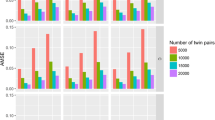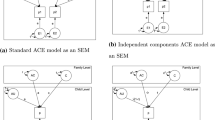Abstract
For many phenotypes, individual scores are obtained as the parameter estimates of person-level models fit to intensive repeated measures from physiological sensors or experience sampling studies. Biometrical genetic analysis of such phenotypes is often done in a 2-step sequence: first the phenotypic parameters are estimated for each individual, then classical twin modeling is used to partition their variance. This study demonstrates deficiencies in accuracy and statistical power of the two-step approach to estimate genetic signals and advocates for the use of hierarchical models to overcome both problems. Simulations are used to demonstrate the benefits to accuracy and statistical power from a hierarchical modeling approach. A model of heart rate fluctuations was applied to experimental data from twin pairs recorded in independent trials. Results of the data application reveal moderate but uncorrelated heritabilities for two parameters of heart rate: oscillation frequency and damping ratio. By merging biometrical genetic analysis with process models, hierarchical mixed-effects modeling has potential to assist with discovery and extraction of novel phenotypes from within-person data and to validate theoretical models of within-person processes.



Similar content being viewed by others
Notes
ACE refers to a twin model with additive genetic (a), common environmental (c), and unique environmental (e) variance components but is used colloquially to symbolize twin modeling in general, though other specifications such as allelic dominance (d) are common.
References
Acharya UR, Joseph KP, Kannathal N, Lim CM, Suri JS (2006) Heart rate variability: a review. Med Biol Eng Comput 44(12):1031–1051
Åström KJ, Murray RM (2008) Feedback systems: an introduction for scientists and engineers. Princeton University Press, Princeton
Bar-Shalom Y, Li X-R, Kirubarajan T (2002) Estimation with applications to tracking and navigation: theory. Algorithms and software. Wiley, New York
Bastos A, Schoffelen J (2016) A tutorial review of functional connectivity analysis methods and their interpretational pitfalls. Front Syst Neurosci 9:175–175
Bob C, Andrew G, Hoffman MD, Lee D, Goodrich B, Betancourt M, Brubaker M, Guo J, Li P, Riddell A (2017) Stan: A probabilistic programming language. J Stat Softw 76(1):1–32
Boker SM (2002) Consequences of continuity: the hunt for intrinsic properties within parameters of dynamics in psychological processes. Multivar Behav Res 37(3):405–422
Bollen KA (1989) Structural equations with latent variables. Wiley series in probability and mathematical statistics. Applied probability and statistics. Wiley, New York. https://doi.org/10.1002/9781118619179.
Dolan CV, de Kort JM, van Beijsterveldt TCEM, Bartels M, Boomsma DI (2014) Ge covariance through phenotype to environment transmission: an assessment in longitudinal twin data and application to childhood anxiety. Behav Genet 44(3):240
Douc R, Moulines E, David S (2014) Nonlinear times Series : Theory, methods and applications with R examples, Texts in statistical science
Driver CC, Oud JHL, Voelkle MC (2017) Continuous time structural equation modeling with R package ctsem. J Stat Softw 77(5):1–35
Eid M, Diener E (1999) Intraindividual Variability in affectt; Reliability, validity, and personality correlate. J Pers Soc Psychol 76(4) 662–676
Eysenck HJ, Prell DB (1951) The inheritance of neuroticism: an experimental study. J Mental Sci 97(408):441
Hektner JM (2007) Experience sampling method: measuring the quality of everyday life. Sage Publications, Thousand Oaks
Hoffman MD, Gelman A (2014) The no-u-turn sampler: adaptively setting path lengths in Hamiltonian Monte Carlo. J. Mach. Learn. Res. 15(1):1593–1623
Hunter MD (2018) State space modeling in an open source, modular, structural equation modeling environment. Struct Equ Model 25(2):307–324
Kalman RE, Bucy RS (1961) New results in linear filtering and prediction theory. Trans ASME Ser D 83:95–108. https://doi.org/10.1115/1.3658902
Kalman RE et al (1960) Contributions to the theory of optimal control. Bol. Soc. Mat. Mexicana 5(2):102–119
Kendler KS, Aggen SH, Czajkowski N, Røysamb E, Tambs K, Torgersen S, Neale MC, Reichborn-Kjennerud T (2008) The structure of genetic and environmental risk factors for dsm-iv personality disorders: a multivariate twin study. Arch General Psychiatry 65(12):1438–1446
Kuppens P, Mechelen IV, Nezlek JB, Dossche D, Timmermans T (2007) Individual differences in core affect variability and their relationship to personality and psychological adjustment. Emotion (Washington, D.C.) 7(2):262–274
MacKay DJ (2003) Information theory, inference and learning algorithms. Cambridge University Press, Cambridge
Mcardle JJ, Epstein D (1987) Latent growth curves within developmental structural equation models. Child Development 58(1):110–133
Mcelreath R (2016) Statistical Rethinking: A Bayesian course with examples in R and Stan. Vol. 122, 1st edn. Chapman & Hall/CRC Texts in statistical science
McKee KL, Neale MC (2019) Direct Estimation of the Parameters of a Delayed, Intermittent Activation Feedback Model of Postural Sway during Quiet Standing. PloS One 14(9):E0222664
McKee K, Russell M, Mennis J, Mason M, Neale M (2020) Emotion regulation dynamics predict substance use in high-risk adolescents. Addict Behav 106:106374
McNeish D, Hamaker EL (2020) A primer on two-level dynamic structural equation models for intensive longitudinal data in mplus. Psychol Methods 25(5):610–635
Moscati A, Verhulst B, McKee K, Silberg J, Eaves L (2018) Cross-lagged analysis of interplay between differential traits in sibling pairs: Validation and application to parenting behavior and adhd symptomatology. Behav Genet 48(1):22–33
Neale MC, Hunter MD, Pritikin JN, Zahery M, Brick TR, Kirkpatrick RM, Estabrook R, Bates TC, Maes HH, Boker SM (2016) Openmx 2.0: extended structural equation and statistical modeling. Psychometrika 81((2):535
Nesselroade JR (2002) Elaborating the differential in differential psychology. Multivar Behav Res 37(4):543–561
Oravecz Z, Tuerlinckx F, Vandekerckhove J (2011) A hierarchical latent stochastic differential equation model for affective dynamics. Psychol Methods 16(4):468–490. https://doi.org/10.1037/a0024375
Ou L, Hunter Michael, D, Chow S-M (2019) Whats for dynr: a package for linear and nonlinear dynamic modeling in R. R J 11(1):91
Plomin Robert (1990) Nature and nurture: an introduction to human behavioral genetics. Brooks/Cole Pub. Co., Pacific Grove
R Core Team (2019) R: a language and environment for statistical computing. R Foundation for Statistical Computing, Vienna, Austria
Roberson-Nay R, Latendresse SJ, Kendler KS (2012) A latent class approach to the external validation of respiratory and non-respiratory panic subtypes. Psychol Med 42(3):461–474
Roberson-Nay R, Moruzzi S, Ogliari A, Pezzica E, Tambs K, Kendler KS, Battaglia M (2013) Evidence for distinct genetic effects associated with response to 35 co2: research article: evidence for distinct genetic effects. Depress Anxiety 30(3):259–266
Roberson-Nay R, Beadel JR, Gorlin EI, Latendresse SJ, Teachman BA (2014) Examining the latent class structure of co2 hypersensitivity using time course trajectories of panic response systems. J Behav Therapy Exper Psychiatry 47:68–76
Röcke C, Li S-C, Smith J (2009) Intraindividual variability in positive and negative affect over 45 days: Do older adults fluctuate less than young adults? Psychol Aging 24(4):863–878
Shiffman S, Stone AA, Hufford MR (2008) Ecological momentary assessment. Annu Rev Clin Psychol 4:1. https://doi.org/10.1146/annurev.clinpsy.3.022806.091415
Tambs K, Czajkowsky N, Neale MC, Reichborn-Kjennerud T, Aggen SH, Harris JR, Kendler KS et al (2009) Structure of genetic and environmental risk factors for dimensional representations of DSM-iv anxiety disorders. Br J Psychiatry 195(4):301–307
Vallacher RR, Van Geert P, Nowak A (2015) The intrinsic dynamics of psychological process. Curr Directions Psychol Sci 24(1):58–64
William WSW (2006) Time series analysis : Univariate and multivariate methods. 2nd edn. Pearson Addison Wesley, Boston
Acknowledgements
Special thanks go to Roxann Roberson-Nay (Virginia Commonwealth University) for providing the heart rate data and Daniel Lee (Columbia University) for technical troubleshooting, guidance with Stan model code. Additional thanks go to Michael Neale (Virginia Commonwealth University) and Steven Boker (University of Virginia) for prompting discussion and work on this topic.
Funding
Research reported in this publication/presentation/work was supported in part by the National Center For Advancing Translational Sciences of the National Institutes of Health under Award Number KL2TR003016. The content is solely the responsibility of the authors and does not necessarily represent the official views of the National Institutes of Health.
Author information
Authors and Affiliations
Corresponding author
Ethics declarations
Conflict of interest
Kevin L. McKee declares that he has no conflict of interest.
Ethical approval
This retrospective study involving human participants was in accordance with the ethical standards of the institutional and national research committee and with the 1964 Helsinki Declaration and its later amendments or comparable ethical standards. The Human Investigation Committee (IRB) of Virginia Commonwealth University approved this study.
Informed consent
Informed consent was obtained from all individual participants included in the study.
Additional information
Publisher's Note
Springer Nature remains neutral with regard to jurisdictional claims in published maps and institutional affiliations.
Edited by Matthew Keller.
Rights and permissions
About this article
Cite this article
McKee, K.L. Hierarchical Biometrical Genetic Analysis of Longitudinal Dynamics. Behav Genet 51, 654–664 (2021). https://doi.org/10.1007/s10519-021-10060-0
Received:
Accepted:
Published:
Issue Date:
DOI: https://doi.org/10.1007/s10519-021-10060-0




